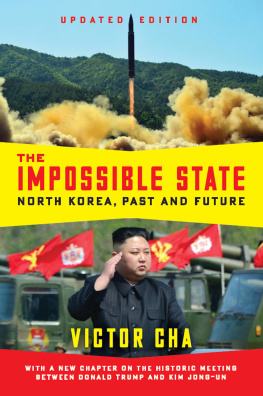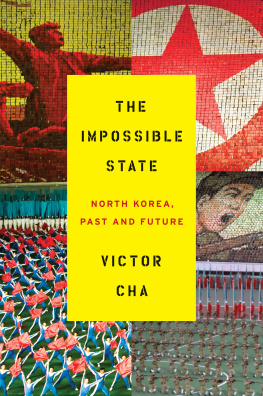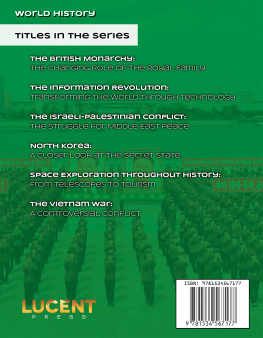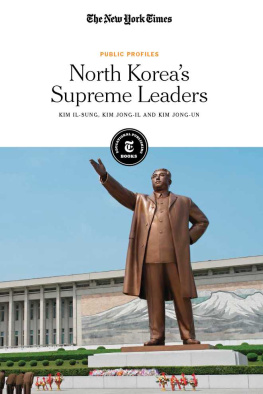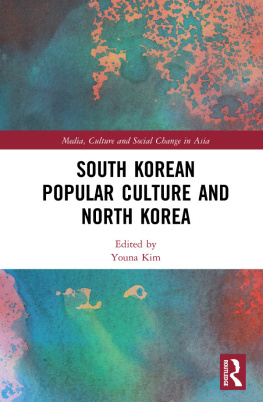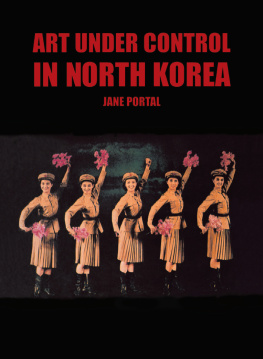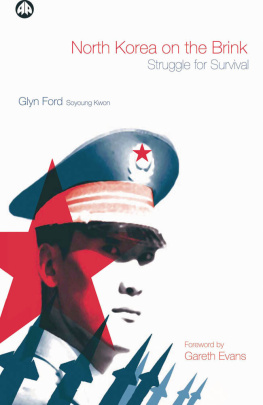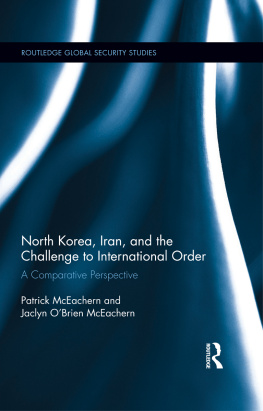Contents
Guide
For my mother, Soon Ock, and my wife, Hyun Jung
Romanization of the Korean language has long suffered from a lack of a single, agreed-upon standard for spelling, which is why you will variously see Kim Jong Il, Kim Jong-Il, Kim Jong-il, and Kim Chng-il in the press and academic publications. The book at hand uses something of a mishmash of different standardized Romanization techniques. For names and places that will be familiar to many readers, such as Kim Il-sung, Kim Dae-jung, and Pyongyang, Revised Romanization is used. For names of people and places less familiar to the casual observer, McCune-Reischauer Romanization is used. And for those who arent acquainted with Korean, Chinese, or Japanese names, it bears pointing out that in nearly all cases (with the exception of a few, whose names are widely known and/or used in the reverse order, such as Syngman Rhee), Korean, Chinese, and Japanese names are written in their traditional order, with the surname first and the given name last.
THE IMPOSSIBLE STATE WAS THE FIRST BOOK PUBLISHED AFTER THE DEATH OF NORTH Koreas second leader, Kim Jong-il, and the sudden ascension to the leadership of his twentysomething-year-old son, Kim Jong-un. At the time, the future for this small isolated regime appeared uncertain at best, and that of its young leader far from bright. Since publication of that first edition, however, so much has happened, most of it worrisome. The world saw North Korea conduct seventy-two ballistic missile tests and four nuclear detonations that demonstrated not only rapid advancements in their capabilities, but also progress toward threatening the U.S. homeland with a nuclear-tipped ballistic missile.
The United States did little to address this threat during the eight years of Barack Obamas administration. Pursuing a policy of strategic patiencedefined as not wasting political capital or diplomatic energy on a negotiation without some (unlikely) sign of North Korean interestObama preferred to focus on opening relations with Burma and Cuba, and investing politically in a nuclear agreement with Iran rather than North Korea.
In South Korea, we saw the impeachment of the conservative government led by President Park Geun-hye, and the election of the first progressive government in the country in a decade, devoted to improving relations with North Korea through diplomatic and economic engagement policies. The period since publication of The Impossible State also saw an extraordinary deterioration in Chinas relations with both Koreas. In the case of the North, Chinas leader Xi Jinpings distaste for the young Kims belligerence resulted in an extraordinary period of non-dialogue that came to a close only in 2018. With South Korea, China embarked on a draconian economic sanctions campaign against it for acceding to the emplacement of an American missile defense battery in the country.
But most important, the intervening years saw Kim Jong-un declare at the end of 2017 that after one half century of development, North Korea had achieved the status of a nuclear weapons state. As I discuss in The Impossible State, the regime devoted an inordinate percentage of its national resources to this project. It started, based on newly obtained archival CIA satellite imagery, in 1962, two years before China exploded its first nuclear bomb. This was indeed a watershed moment for the country, and it is appropriate that the second edition of my book picks up from this development. In 2018, we saw a flurry of diplomacy unprecedented in history. The North Korean leader, normally isolated from the entire world, held three summits with Xi Jinping, two summits with South Korean president Moon Jae-in, and a historic meeting with the American president Donald Trump in Singapore. Is this diplomacy an effort at peacemaking with de facto acceptance by the international community of North Korea as a nuclear weapons state? Or is this diplomatic outreach a new effort by Kim to shed his isolation and seek reconciliation with longtime adversaries?
At the end of the first edition of The Impossible State, I wrote that there would be some major political discontinuity involving North Korea during the term of the forty-fifth president of the United States. I did not specify whether that discontinuity would be negative or positive, but believed that the status quo could simply not hold. I still support that prediction and would argue that some of the things we have seen so far have already validated that claim. But what I did not expect was that the source of this change might come from an unpredictable and impulsive U.S. president. Donald Trump is unlike any U.S. president who has dealt with North Korea. And so I think it is appropriate that the epilogue focus as much on him as on the North Korean leader because this presidents unconventionality could take the Korean peninsula in the direction of a peace treatyor in the direction of a horrible war.
2018
Contents
WE PASSED OVER BARREN AND GRAY FIELDS AS THE GULFSTREAM VI TOUCHED DOWN on the empty runway of the airport. As the plane taxied on the tarmac, there was no flight traffic to be seen. No baggage carts or fuel trucks shuttling about. It looked as though we were the only arrival or departure of the day. We cruised past two passenger planes with propeller engines, the kind you would see in a 1940s Humphrey Bogart movie. Then the plane turned right and the main terminal came into view, a small 1960s-era building about one-tenth the size of todays international air terminals. Scrawled across the top of the edifice with large, red block letters was PYONGYANG, written in English and in Hangl (Korean characters). Hanging atop the center of the Sunan international air terminals faade was an oversize portrait of the first leader of the Democratic Peoples Republic of Korea (DPRK, North Korea), Kim Il-sung.
We prepared to deplane into the cool spring air, after the long flight from Elmendorf Air Base in Alaska. It was dusk with an orange glow to the sky, and it was eerily silent: no street sounds, no car horns, no birds. We disembarked one by one, following established security protocol, while two security officers, known as ravens, checked each of our names off the passenger manifest. The ravens then escorted us to a receiving party of North Korean airport staff and foreign ministry officials, who were standing on the tarmac in front of the Kim Il-sung portrait. It was at that point that our security detail turned around and headed back to the plane. I blurted out, Hey, arent you guys coming with us? The agent, looking puzzled at my naive question through his dark sunglasses, responded, No sir, we stay with the plane. Too much sensitive comms equipment aboard to stay overnight in enemy territory. We will transport southbound to Osan [air base in South Korea]. See you on the other side in a few days, sir. The Gulfstream VI was a military plane that the White House provided at the request of New Mexicos then-governor Bill Richardson who had pressed the George W. Bush administration to allow him to visit North Korea. The plane was capable of confidential communications (and probably a whole host of other things I was unaware of). I then remembered that the ravens, who were fully armed, always checked us on and off the plane at our various stops along the way, but the only time they ever separated from the plane was when we overnighted at Elmendorf Air Force Base, a secure facility. I thought to myself, U.S. military plane, invaluable; U.S. government officials, expendable.
My job on this trip as National Security Council (NSC) staff was to accompany the governor and make sure he did not make any nuclear deals outside of the ones we were then trying to negotiate through the Six-Party Talks. Our specific mission was to negotiate the successful return of a set of POW/MIA (Prisoners of War/Missing in Action) remains from the Korean War that was held by the Korean Peoples Army (KPA). Two experts from the Defense Department were detailed for the trip. One was a forensics expert. The other was a Central Asia policy expert, who also was a Ph.D. candidate at Georgetown University, and on whose dissertation committee I later served. Richardson, then about to announce his candidacy for president on the Democratic ticket, was the media highlight of the trip (he had brought with him Andrea Mitchell of NBC News and an Associated Press correspondent, to ensure adequate publicity), but this was the first time U.S. officials from the second term of the Bush administration had entered North Korea. The last time had been in 2002, when the United States confronted North Korea about a clandestine second nuclear program that was in violation of standing agreements. This sparked a major crisis that led to ballistic missile tests and, ultimately, a nuclear test by Pyongyang. So no one knew exactly what to expect.

